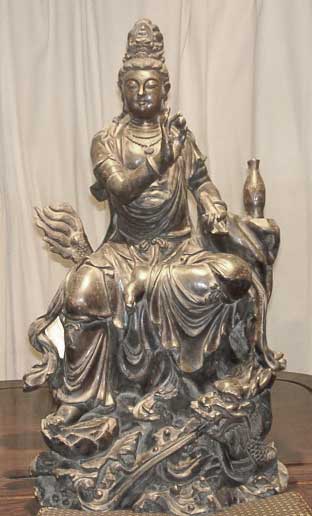
Gallery II
In the Asian Style
Ever since the Europeans sailed the seas to trade with the East, the West has looked towards the Orient for exquisite art objects. Today many of the finest art objects and antiquities from the Orient are housed in private collections or museums in the West.
Many of us cannot afford museum quality pieces. However there is still plenty of Asian art to be found. The phrase Asian art or Asian style is preferred because the word "Oriental" has too much reference to China only. But with increased travel opportunities exquisite Asian art is not restricted geographically to China. Good art is found in many South East Asian countries. Persia, Pakistan, India and Afghanistan weave fine "Oriental" rugs and carpets. Buddha statuary originally from India or Gandara in present day Afghanistan, have their own style in Tibet, Nepal, Myanmar (Burma), Thailand, Cambodia and even Java. Japanese art from byobu (screens) to tansus (chests) to Zen scrolls has its own aesthetic appeal.
Art from any of these countries give a decorative impact for any home or commercial space. No matter how Western the interior design, Asian art will always have a place to enhance the space. A few examples follow.

This 34" high wooden statue of Quan Yin (or Kuan Yin). Sanskrit Padmapani or "Born of the Lotus." The Chinese Goddess of Mercy signifies "She who always observes or pays attention to sounds," i.e., she who hears prayers. Corresponds to Avalokitesvara in India and Kannon in Japan.
This statue is carved from one solid piece of (likely) "Tan mu" which emits a sweet fragrance. "Tan mu" is traditionally used in religious statuary and rosary beads.
Here Quan Yin sits in Lalitasana posture with one leg placed parallel to the ground and the other pendant, resting on a lotus blossom. She holds a pearl in her right hand that is concomitant to the dragon. The dragon is at the bottom of her parallel left leg. The left hand holds a scroll symbolizing the sacred texts of Buddhist scriptures and the store of truth.

Kesi is a style and method of stitching to produce ultra-fine silk tapestries which incorporate gold threads. Chinese kesi contain up to 56 warp threads per inch compared with European Gobelin tapestries with 20-28 warps. The dazzling array of Chinese silk designs employ a wide range of religious and secular symbols.
Here you see a lady's jacket, probably worn in the imperial court. The main kesi design on the front is a dragon with another pair emerging from the ocean at the bottom of the jacket. Above the ocean kesi work is a pair of phoenixes. The design is repeated on the back of the jacket. A dragon each adorn the shoulders. In total there are eight dragons and two pairs of phoenixes. The edges of the jacket are lined with embroidery and lace. Probably late 1800's to early 1900's.
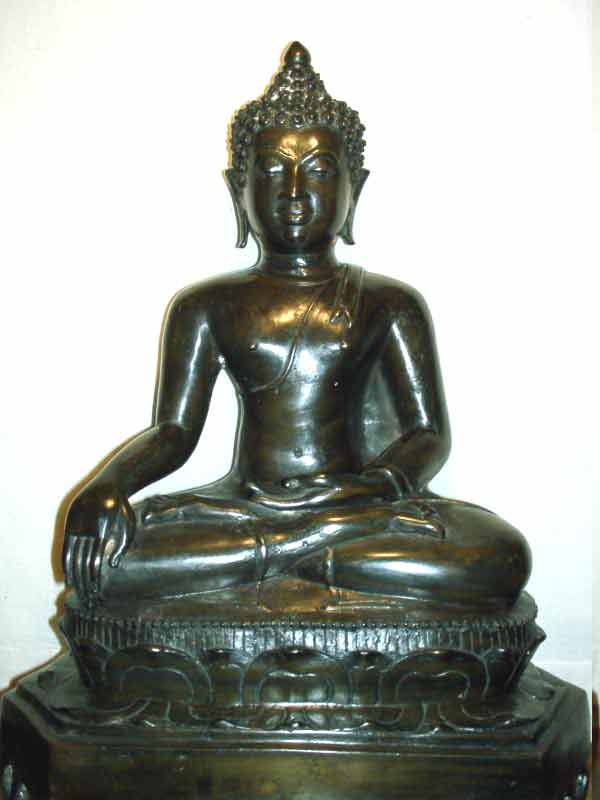
Bronze Buddha 21.5" high. Buddha is seated on a lotus blossom in the sacred gesture of Bhumisparsamudra in which the right hand is extended to touch (sparsa) the earth (bhumi) . Buddha Sakyamuni is said to have made this gesture as he became enlightened below the Bodhi tree after having resisted the temptation of Mara, the Buddhist god of desire. Since there was no one else around, he called on the earth to witness his victory over Mara.
The style is probably Dvaravati, named after the kingdom of the same name, which flourished in southern Thailand between the sixth and eleventh centuries. The image also reflects the general influences of the Gupta tradition.
The face has a noble and compassionate expression. The half shut eyes convey a sense of introspective calm. The ushnisha i.e. the cranial bumps on the Buddha's head, signify supernatural wisdom. It is surmounted by a slightly pointed ball. The fold of the sanghati across the left shoulder is a subtle translucent veil across the bodice.
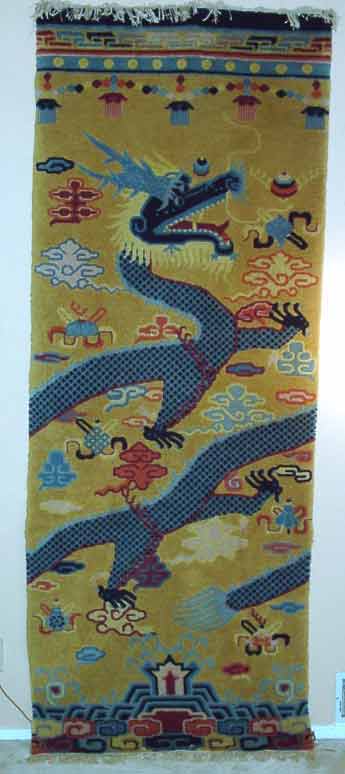
Dragon Pillar Rug: Dragons symbolize the yang element, Lord of the East and the sunrise, the bringer of rain. It's five claws indicate imperial court status where it is the emblem of the emperor. This is a fine example of a rug that the temples use to wrap around the cylindrical columns. One of a pair.
Below the dragon, the sacred mountain rises out of the eternal waves. This places the dragon in a celestial realm. Before the dragon's mouth is the flaming jewel, the "pearl of potentiality," the wish fulfilling pearl. Clouds drift intermingled with other symbols. Like the never ending mystic knot; the vase, perfect wisdom; the umbrella, sovereignity. Above the dragon's head is a rich string of lanterns.
There are no side borders to interfere with wrapping the long rug around the temple pillar columns so the dragon spirals down thus appearing to circle the pillar.

Pair of Fu Lions: Wood, gilded, 13" high. They figure in Buddhism as the defender of law and protector of sacred buildings. It is an emblem of valor. The male lion is represented playing with a hollow ball. The ball may represent the sun, the egg symbol of the dual powers of nature, or merely a precious stone. The lioness is generally accompanied by its cub at its left paw.
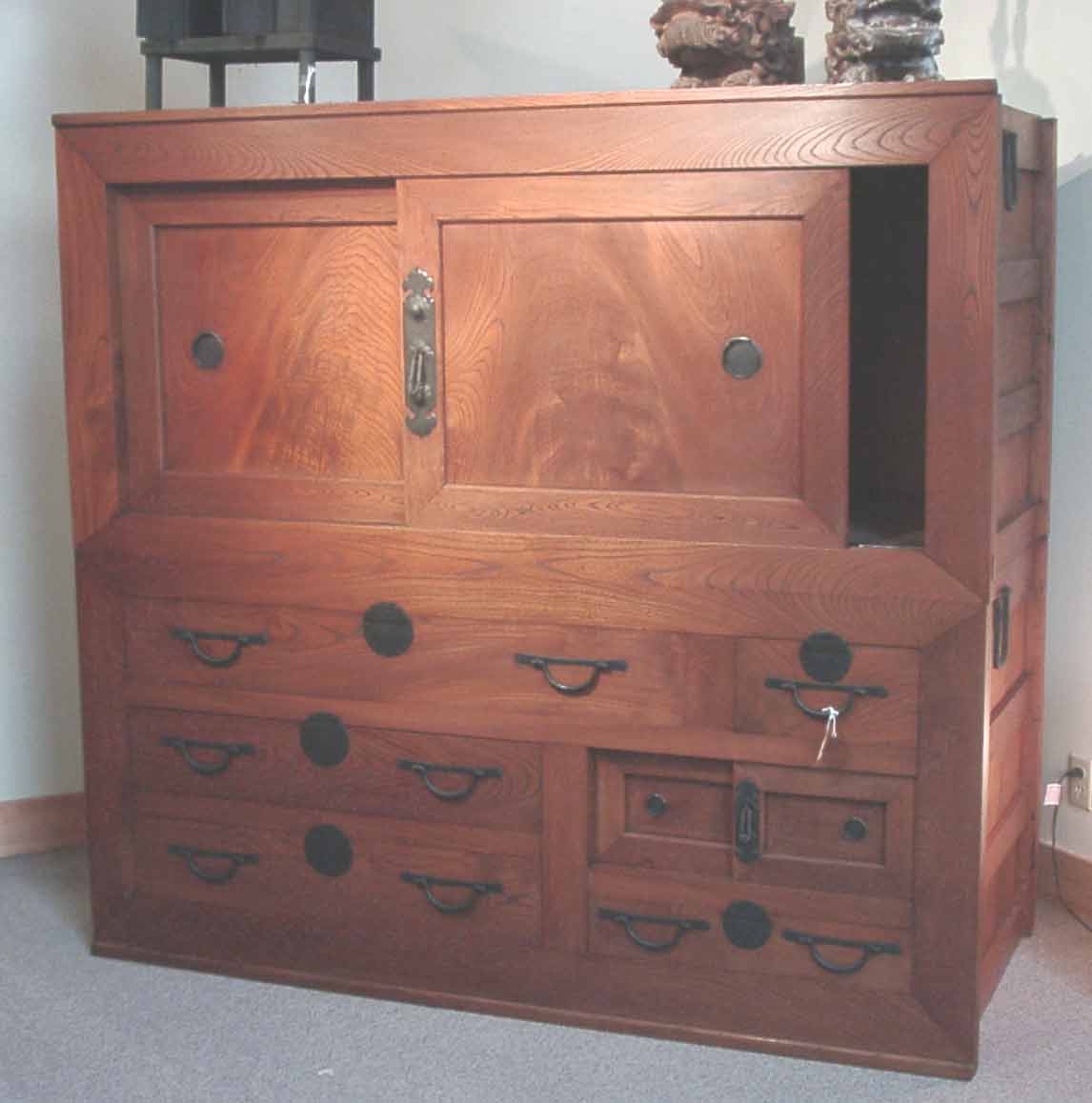
Futon Tansu. These Japanese chests were originally designed in the 1880s for the storage of bedding (futons). They are generally made from zelkova (keyaki) or Japanese cypress (hinoki) wood. This one comes in two sections which can be separated. The top section makes a marvelous entertainment center with sliding doors that can be easily removed and put back.
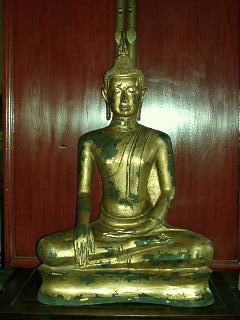
Buddha U-tong (early Ayutdhya) Style. Sitting in Bumisparsamudra position this gilded statue is 32" tall. Buddha has the protruberance on top of his head known as Usnisha and signify great wisdom. The long earlobes indicate royal birth.
Home: Jeffrey Lim Associates Asian Interior Design
Feature Gallery1/The Splendour Of Thai Buddha Bronze Sculpture
Feature Gallery2/Chinese Rugs from Art Deco 1930s or Earlier